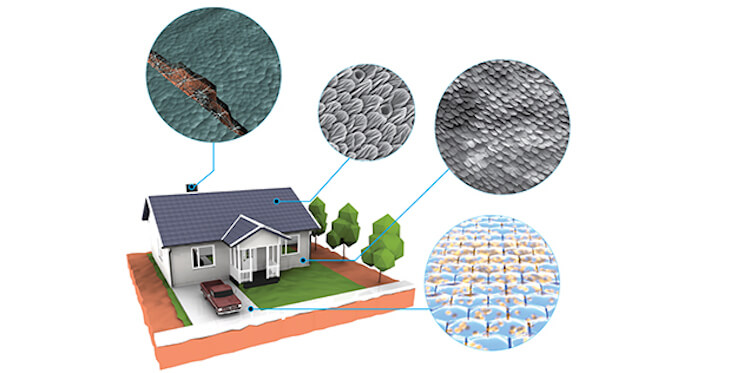
In 2020, the global COVID-19 pandemic had caused unprecedented disruption. For the construction industry, trends like the rise of teleworking, requirements for social distancing, shifts of resources, breaks in supply chains, and cash flow disruption spell change at every level. Still, some trends will, against all odds, continue, if maybe a little bit changed. Here are the 10 construction industry trends we see on the horizon for 2021.
August 2021 Report: 13 Fintech Companies Transforming Construction Finance
10 Trends in Construction
1. Safety

Safety is always a concern, but in the Covid-19 environment it rises to the top of the list. Adjustments to mitigate the spread of disease will focus on separation of workers and enhanced equipment and cleanliness protocols.
Separation is a particularly difficult thing to achieve on a jobsite, where cooperation and teamwork are the norm. Anticipate smaller crews and the use of staggered shifts to keep job sites less crowded.
Enhanced protocols will include the expected things, like masks and hand sanitizer, as well as things specific to construction. The passing around of tools, sharing of gloves and hard hats will be curtailed. We’ll all likely be writing our names on things and using only our own protective equipment.
2. Living Materials

One of the most exciting construction trends to watch is the development of living materials. These biological compounds literally grow themselves, and are poised to move from interesting experiments to full-scale production in the very near future. The upside is just too great for these materials to remain exotic.
The most promising biological materials are built by and made of bacteria and fungi. This makes them light, strong and weirdly portable. The phrase “grown in place” might soon be as common as “cast in place.”
Self-Mending Concrete refers to concrete saturated with bacteria that bind materials around them into a new structural material. This material can grow in the pores of concrete, adding to it’s impermeability. It can even grow into fissures and cracks, filling and repairing them – all on their own. The bacteria are also being developed as a building material unto themselves and have already been grown in usable shapes and sizes.
And then there are Mycelium Composites. Instead of bacteria, these materials are the work of fungi. Mycelium is the vast network of fungi living underground, the flowers of which are mushrooms. The largest living organism on Earth is a Honey Fungus in Oregon that’s 2.5 miles across (1,665 football fields), several thousand years old, and makes tasty mushrooms. Scientists have harvested this robust creature, growing it into all sorts of materials by feeding it farm waste.
Dell Computers packs their high-end gear in mycelium materials in place of the not-so-environmentally-friendly Styrofoam packing peanuts. And production is already under way for insulation and flooring.
3. Remote Technology

“Remote” is the world of the times and anything that promises that a task can be completed remotely is going to grow quickly. This is true for both building tasks and administrative tasks.
Almost no commercial jobsite now is without a Drone. Construction is the fastest growing adopter of commercial drones according to DroneDeploy, a drone surveying and mapping app. By peering down at a project from above, contractors find invaluable information. Safety issues are quickly discovered, quantities of materials on site can be accurately estimated, and orthomosaic maps can be created making even the largest job site visible as a whole. Substantial financial savings are achievable as a result. Safety information can reduce insurance claims, accurate assessment of materials and progress can lead to more timely information for Pay Requests and can help make necessary adjustments to manpower and scheduling to avoid delays.
In the office, technology is greatly enhancing the flow of information. Blockchain technology is a method of user-verified, real time input of an endless number of data points, from transactions, to payments, to completion of tasks and revisions of schedules.
This technology is becoming simpler to use and is being rapidly adopted in large-scale work, with inroads now being made even on smaller jobs.
4. 3-D Printing

No technology reduces job site worker density (for good and bad) like 3D printing. In the field, it’s essentially a big nozzle methodically laying concrete in vertical piles according to a programmed design.
This method is already in commercial use around the world and is expected to grow rapidly. Recently, a 3D homebuilding company raised $35m after printing an entire neighborhood in Mexico.
Want to see it in action? Check out this time-lapse video of 3-D printing a 2-story building in Dubai.
In the factory, it’s the same process on a smaller scale. Typically, the process is used to make small components of larger assemblies, usually out of plastic. Though it will likely never replace injection moulding for mass production, 3D printing is making the manufacture of custom pieces affordable. Watch for designers to take full advantage of this.
5. Modular Construction

Modular construction and pre-fab building, which was already steadily on the rise, should see a huge boost in interest in the post-pandemic era. Both the manufacturing process and the result are perfectly suited for the times.
Manufactured buildings are already built in a way that promotes low worker density. The manufacturing is done in enormous, airy buildings, with plenty of room for distancing. And the equipment used — ceiling cranes, conveyors, and lifts — is specifically designed to let fewer workers move larger components, reducing worker proximity and labor costs.
Once manufactured, these buildings are typically small, limited by the ability of trucks to move them. As a result, they’re perfect for a world where separation is required.
They are ideal if a business needs individual offices with independent systems, a remote worker needs an office at home, or a hospital needs a few additional rooms. Prefabricated buildings have the dual advantage of being affordable and also potentially temporary. In times of uncertainty, a temporary solution is often the best option. This construction trend isn’t going anywhere.
6. Design Technology: BIM & VDC

Design technology has already been a popular construction trend before the pandemic, and there’s simply no stopping or disrupting it. The promise of constructing the building in virtual space before building it in real life is just too great to be ignored by either designers or contractors.
For Architects, Building Information Modeling (BIM) has taken over the industry, replacing CAD as quickly as CAD replaced pencils. Programs like industry leader REVIT are not just drafting programs, they’re a fundamental re-thinking of the design and production process.
In fact, there are no drawings at all in BIM, only a model of the building in virtual space that you take images of to make the drawing set. It allows the designer to actually construct the building in the virtual world as a practice run for it being built in the real world.
For builders, this is even more valuable. Often referred to by contractors as VDC (Virtual Design and Construction), the principle is the same. Imagine finding all the pitfalls of a project — the difficult connections, the coordination issues, the necessary but unaccounted for components — before a shovel of dirt is turned over. The cost savings can be incredible in the field and in the office. You can check out his ConstructionDive article for an overview.
7. Work Disruptions

The work of the construction industry is tied to one thing: capital. And capital dislikes uncertainty. The current climate is making it difficult to finance projects, particularly large ones.
Overall, the AIA expects spending on non-residential buildings to decline in 2021 and the drop-off could be dramatic. As government debt at every level increases, spending on infrastructure projects will almost certainly be delayed. And in the private industrial sector, the slowdown has already begun.
8. Payment Disputes

It’s inevitable that, when money gets tight and conditions get confusing, the flow of money will become an issue. Already we know that bankruptcies are on the rise and we can only expect this trend to get worse, with both construction companies and building owners meeting this fate.
Though there will surely be a rise in lawsuits, before that will come a wave of mechanic liens, an instrument that contractors and sub-contractors use to lay claim to a portion of the property as a mechanism for collecting payment owed. Usually even the Notice of Intent to file a lien will resolve a pay dispute and, if a lien is ultimately filed, they seldom lead to foreclosure, as there are many opportunities along the way for resolution.
However, with payment being disrupted, we can expect some fairly exotic maneuvering by contractors and owners on the lien space, including selling a claim. Levelset has even started offering cash up front for lien or bond claims to contractors who have protected their payment rights.
9. Supply Chain Diversification

The disruption to supply chains has forced contractors to scramble to find alternative suppliers or to pay higher prices for materials. There’s no indication that this is going to improve in the near term.
This construction trend will mean reevaluating long term business relationships and brand loyalties and taking risks on new alliances. As usual, this risk will come at a cost, and it will take intense coordination from suppliers, subs, generals, and owners to make timely, informed decisions on alternates.
New contracts will likely put more emphasis on escalation clauses to cover unforeseen cost increases, and current contracts may need to be similarly revised. But it’s also an opportunity for nimble suppliers and contractors to move into areas and clientele that might have previously been difficult to access.
10. Drop in Non-Residential Starts

Non-residential building starts are down in 2020. Way down. According to a report from Dodge Data and Analytics, they’re down 31% just from June to July, But, at the same time, residential starts were up 22.6%, the lion’s share of which were multi-family projects with over five units.
Much of the surge in houses is credited to low interest rates, but it seems also to be being fueled by the pandemic as people look to move to individual apartments and to move away from crowded urban centers, reversing a decades-long trend.
In the non-housing sector, blame for the downturn goes to uncertainty. Investment in buildings as large and expensive as office buildings towers and and hotels, two enormous parts of the commercial building market, are tough to make if the future of the industries they house are in question. However, there is some cause for hope.
Architects report that hospitality projects, for instance, seem to be on hold rather than cancelled. Some hotels are even planning to use their low occupancy to carry out renovations that otherwise would have been disruptive to guests.
Takeaways for Construction in 2021
Though it’s obviously impossible to really predict the future, we can make educated guesses and look to history for guidance. However, with families forced to cancel their vacations and socialize outdoors, there’s one type of construction that’s unexpectedly booming and showing no sign of slowing: swimming pools.